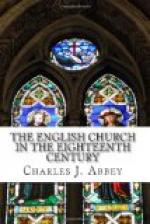The subject carries us back in thought to the earliest days of Christianity. During the first four centuries, the nature of the Godhead, and the relation of the Three Persons of the Trinity to each other, were directly or indirectly the causes of almost all the divisions which rent the Church. They had been matters of discussion before the death of the last surviving Apostle, and the three centuries which followed his decease were fruitful in theories upon the subject. These theories reappear with but little alteration in the period which comes more immediately under our present consideration. If history ever repeats itself, it might be expected to do so on the revival of this discussion after an abeyance of many centuries. For it is one of those questions on which modern research can throw but little light. The same materials which enabled the inquirer of the eighteenth century to form his conclusion, existed in the fourth century. Moreover, there was a tendency in the discussions of the later period to run in an historical direction; in treating of them, therefore, our attention will constantly be drawn to the views of the earlier thinkers. With regard to these, it will be sufficient to say that their speculations on the mysterious subject of the Trinity group themselves under one or other of these four heads.
1. The view of those who contend for the mere humanity of Christ—a view which, as will be seen presently, is often claimed by Unitarians as the earliest belief of Christendom.
2. The view of those who deny the distinct personality of the Second and Third Persons of the Blessed Trinity. This was held with various modifications by a great variety of thinkers, but it passes under the general name of Sabellianism.
3. The view of those who hold that Christ was something more than man, but less than God; less than God, that is, in the highest, and indeed the only proper, sense of the word God. This, like the preceding view, was held by a great variety of thinkers, and with great divergences, but it passes under the general name of Arianism.
4. The view of those who hold that ’there is but one living and true God,’ but that ’in the Unity of this Godhead there are three Persons, of one substance, power, and eternity—the Father, the Son, and the Holy Ghost.’ This view is called by its advocates Catholicism, for they hold that it is, and ever has been, the doctrine of the Universal Church of Christ; but, inasmuch as the admission of such a name would be tantamount to giving up the whole point in question, it is refused by its opponents, who give it the name of Athanasianism.
In England, the Trinitarian question began to be agitated in the later half of the seventeenth century. Possibly the interest in the subject may have been stimulated by the migration into England of many anti-Trinitarians from Poland, who had been banished from the country by an Order of Council in 1660. At any rate, the date synchronises with the re-opening of the question in this country. It is probable, however, that under any circumstances the discussion would have arisen.




